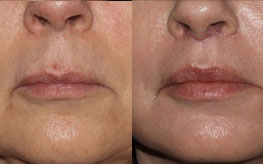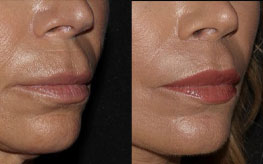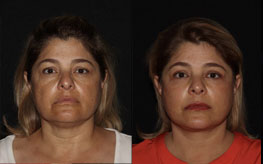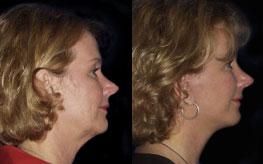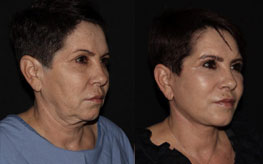Eyelid Surgery For Men
Conveniently located to serve the areas of San Diego, CA

Cosmetic eyelid surgery, or blepharoplasty in San Diego (blef-row-plas-tee), improves the appearance of the upper eyelids, lower eyelids, or both. This results in a rejuvenated appearance to the surrounding area of your eyes, making you look more rested and alert.
Specifically, eyelid procedures are ideal for getting rid of a tired appearance caused by:
- Loose or sagging skin that creates folds or disturbs the natural contour of the upper eyelid, sometimes impairing vision
- Excess fatty deposits that appear as puffiness in the middle part of the upper eyelids
- Bags under the eyes
- Droopiness of the lower eyelids, showing white below the iris (colored portion of the eye)
- Excess skin and fine wrinkles of the lower eyelid
For more information about our eyelid lift procedure, please contact us online or call us at 888-463-9532. We look forward to helping you look your best.
Contents
Before and After Photos
Understanding the Eyelid Lift Procedure
At Alexander Cosmetic Surgery, the Eyelid Lift is one of our most requested procedures, performed on an almost daily basis. It is one of the most predictable procedures patients can undergo, causing little to no pain and requiring little down time.
In our experience, we have found that most patients are currently satisfied with how they look—they’re just unhappy with changes caused by age. Patients don’t want to alter the nature of their face, rather they desire to look fresher and younger. In other words, they want to “turn back the clock.” Many patients comment that they look older than they feel, but are wary of cosmetic eyelid surgery, especially if they’ve seen poor outcomes in others. We often hear, “I don’t want to look funny, or surprised.”
We have all seen celebrities, friends, or people on the street with an overdone, surprised surgical look. You will be relieved to know that this “look” can easily be avoided and does not happen accidentally. This unnatural look is usually caused by one of two things.
First, when patients receive a consultation for heavy upper eyelid skin, plastic surgeons too often recommend—and perform—brow lifts in conjunction with upper eyelid surgery. The logic behind this is that a brow lift is also successful in removing unwanted eyelid skin. However, this can frequently result in a brow that is too elevated and unnatural. This procedure can artificially create a rounded, hollow look to the orbital area actually making a patient look older.
Second, some surgeons perform a procedure which disconnects the attachments of the lateral eyelid and repositions it higher creating a turned up, or “cat’s eye,” appearance. Unless the patient already has a very droopy lower eyelid, this procedure will usually lead to an unnatural, pulled appearance.

In our practice we have found that a completely natural result can be obtained by simply tailoring away the extra fold of eyelid skin without changing anything else around the eye. Brow lifts should be avoided except when absolutely necessary. Eyelid Lifts that have been done well should be undetectable and completely natural.
Procedures that can be performed in conjunction with a blepharoplasty in San Diego to further rejuvenate the face are a QuickLift™, a Brow Lift to correct a sagging or deeply furrowed brow, and Chemical or Laser Peels to smooth sun-damaged skin.
Before You Decide…
The Consultation
To ensure the most natural looking-results, it’s imperative for a surgeon to recommend the procedure which most appropriately matches your needs and offer realistic expectations for post-surgery outcomes. When you meet with a surgeon, you should expect a full discussion of the surgically appropriate options for your face, which is unique.
A good surgeon will go through a series of examinations and observations that are individual and depend upon your specific situation and goals. Also factored into this process are the doctor’s expertise, training, and experience. If a surgeon specializes in a particular type of Eyelid Lift procedure, don’t be surprised if it is recommended over other options. Be wary of the “one-size-fits-all” approach. This is particularly important because, as medicine continues to advance, patients have more options made available to them.
The success of your eyelid lift depends very much on your complete candidness during your consultation. We will ask you questions about your health, desires, and lifestyle.
Be prepared to discuss:
- Why you want the surgery, your expectations, and desired outcome
- The options available to you for facial rejuvenation
- Medical conditions, drug allergies, and medical treatments
- Use of current medications, vitamins, herbal supplements, alcohol, tobacco, and drugs
- Previous surgeries
We may also:
- Examine and measure your face
- Take digital photographs for computer imaging
- Discuss your options and recommend a course of treatment
- Discuss likely outcomes of an eyelid lift and any risks or potential complications
- Discuss the anesthesia options available
- Other procedures can further enhance the outcome of an eyelid lift. They include:
- Resurfacing techniques to improve the tone and texture of eyelid skin
- Fat transplantation to the tear trough
Questions to Ask
- Were you trained specifically in the field of plastic surgery?
- How many years of plastic surgery training have you had?
- Do you have hospital privileges to perform this procedure?
- Is the office-based surgical facility accredited by a nationally- or state recognized accrediting agency?
- What procedure is recommended for me?
- Am I a good candidate for this procedure?
- How many procedures of this type have you performed?
- Where and how will you perform my procedure?
- What surgical technique is recommended for me?
- How long of a recovery period can I expect, and what kind of help will I need during my recovery?
- What are the risks and complications associated with my procedure?
- How are complications handled?
- What are my options if I am dissatisfied with the cosmetic outcome of my cheek surgery?
- Do you have before-and-after photos I can look at for this procedure and what results are reasonable for me?
Who is a good candidate?
Eyelid surgery is usually performed on adult men and women who have healthy facial tissue and muscles and have realistic goals for improvement of the upper and/or lower eyelids and surrounding area. Occasionally younger patients, even in their late teens or early twenties, have significant excess of upper eyelid skin or lower eyelid fat that is an inherited, genetic condition and is not associated with the aging process.
An Eyelid Lift may be a good option for you if:
- You are healthy and do not have a life-threatening illness or medical conditions that can impair healing
- You have a positive outlook and specific goals in mind for eyelid surgery
- You do not have serious eye conditions
- You have droopy upper eyelids and/or bags under your eyes
- You look tired or angry even when you are not
You must tell your doctor if you have any of the following medical conditions:
- Glaucoma
- Dry eyes
- Detached retina
- Graves’ disease or any other thyroid disorder
- Cardiovascular disease, high blood pressure, or other circulatory disorders
- Diabetes
Because every case is unique, the only way to accurately determine which procedure is best for you is to consult with Dr. Alexander. Keep in mind that many procedures exist which can rejuvenate the tissue around the eyes, making them look larger and more rested. Our goal is to find which procedure will best suit your facial structure and condition.
What does it cost?
Cost is always an important consideration in elective surgery. However, when choosing a plastic surgeon for an eyelid lift, remember that the surgeon’s experience and your comfort are just as important as the final cost.
A quote will be provided to you after your consult with Dr. Alexander. Be sure to ask about our patient financing plans.
Cost may include:
- Surgeon’s fee
- Operating room and supplies
- Prescriptions for medication
- Medical tests
- Anesthesia fees (if not done under local anesthesia)
To learn more about our partner in payment plans, please visit CareCredit.
The Eyelid Lift Procedure
Prior to surgery, we will have you:
- Take certain medications or adjust your current medications
- Avoid taking aspirin, anti-inflammatory drugs, and herbal supplements as they can increase bleeding
- Stop smoking well in advance of surgery
During a preoperative appointment, usually 1-2 weeks before surgery, we will:
- Get lab testing or a medical evaluation
- Tell you what to do on the night before and morning of surgery
- Discuss the use of anesthesia during your procedure
- Explain post-operative care and follow-up and as well as what help you will need after the procedure
Anesthesia
Medications are administered for your comfort during the surgical procedure. The choices include local anesthesia, intravenous sedation, and general anesthesia. We will recommend the best choice for you based on your personality, your desires, and the complexity of your procedure.
How We Do It
Although eyelid surgery is relatively straightforward, it’s important to remember that the procedure still requires surgery. Even results achieved by a deep laser peel or chemical peel, which help reduce lines and tighten skin, cannot compete with those achieved by a surgical procedure.
The procedure typically takes about 30 minutes for the upper eyelids and 30-60 minutes for the lower eyelids depending on the individual face and certain surgical variables.
There are four basic steps to Eyelid Lift surgery.
Step 1 – Marking
It is important that the eyelids are carefully marked while the patient is in an upright position so that the correct amount of skin will be removed.
Step 2 – The Incision
The incision lines for eyelid surgery are designed so that scars will be well concealed within the natural structures of the eyelid region. Droopy conditions of the upper eyelid can be corrected through an incision within the natural crease of the upper eyelid. Laterally, the incision must be extended slightly beyond the eye to remove the excess skin which is always present in this area. The incision is slanted upward so that the tiny scar will fall into the natural smile line.
Conditions of the lower eyelid may be corrected with an incision just below the lower lash line. Through this incision, excess skin in the lower eyelids is removed.
A transconjunctival incision, one hidden inside the lower eyelid, is an alternate technique to correct lower eyelid conditions and redistribute or remove excess fat. This is often done in younger patients who require no excess skin removal or with a patient who is undergoing a chemical or laser peel of the lower eyelids.
Step 3 – Removing Excess Fat and Skin
Excess skin and fat is removed to provide a youthful, smooth contour to the lids. Occasionally, fat in the lower eyelid is repositioned along the lower orbital rim to fill deep hollows in the tear trough.
Step 4 – Closing
This is the final tailoring step, in which the incisions are meticulously closed with removable sutures. We use removable sutures to improve the healing process and minimize scarring.
Optional Added Step: Sometimes a laser or chemical peel is done on the lower eyelids or “crow’s feet” to smooth out unwanted lines caused by sun damage or aging.
Informed Consent
Pain from the Eyelid surgery is usually minimal. Pain pills are provided but are usually not required after a couple of days.
The decision to have eyelid surgery is extremely personal, and you will have to decide if the benefits will achieve your goals and if the risks are acceptable. In general, the overall risks are very small this type of surgery.
We will explain in detail the risks associated with surgery. You will be asked to sign consent forms to ensure that you fully understand the procedure you will undergo and any risks and potential complications.
Some of the risks with eye surgery are:
- Temporarily blurred vision
- Dry eyes
- Bruising and swelling
- Lid lag, a temporary pulling down of the lower eyelid
- Temporary numbness or discolorationg
- Possibility of revisional surgery
It is very important to ask our surgeons questions about your procedure. It is natural to feel some anxiety beforehand, whether it’s excitement for your anticipated new look or a bit of preoperative stress. Don’t be shy about discussing these feelings with us.
Important Terms to Know
Anesthesia—General: The patient is asleep, requiring that the airway be protected either by a standard breathing tube or by a laryngeal mask (LMA), an inflatable mask that is placed in the back of the throat but not down the trachea. An anesthesiologist releases gases through the airway which put the patient asleep. Drugs may also be given through the IV.
Anesthesia—Local: The surgical area is numbed up with an injection, but the patient is awake. Sometimes a patient will be given an oral medication, such as Valium, to help with relaxation.
Anesthesia— Sedation (Twilight): The patient is made sleepy with medications given through an IV. The level of sedation can be adjusted, from barely sleepy to very sleepy. Occasionally sedation is given by the surgeon, but most of the time it is administered by an M.D. anesthesiologist.
Blepharoplasty: Eyelid surgery to improve the appearance of upper eyelids and/or lower eyelids.
Ectropion: A condition in which the lower eyelid is rolled outward after eyelid surgery; it is often temporary.
Skin Resurfacing: Treatment to improve the texture, clarity, and overall appearance of your skin, usually with a chemical or laser peel.
Tear Trough: A groove or depression below the lower eyelids extending from the nose across the upper cheek.
Transconjunctival Incision: Incision hidden inside the lower eyelid.
Recovery
Although our society is increasingly geared toward instant gratification, rushing the healing process is never a good idea. It’s easy for patients to get a little too active too quickly. Each body has its own pace, and your body’s recovery speed is unique to you. As with any procedure, we have specific guidelines for preparation and recovery.
The Specifics
Recovery times vary from patient to patient. Eyelid lift recovery tends to take about 4-10 days, with the average patient looking very good at about one week. Bear in mind, however, that these are averages. Some individuals may heal more quickly, while others may take longer to fully recover. A patient who tends to have more bruising and swelling than normal will take longer to heal.
Most patients should allow one week before returning to work and other normal day-to-day activities and about two weeks before participating in any kind of exercise or strenuous physical activity.
Following our instructions regarding medications and other post-operative measures is the key to a quick recovery. Herbal medications are available to reduce swelling and bruising and to speed the healing process.
It is important that the surgical incisions are not subjected to excessive force, abrasion, or motion during the time of healing. Avoid wearing any clothing that must go over your head. We will give you specific instructions on how to care for yourself.
You will need someone to drive you to and from surgery and to stay with you for at least the first night following surgery.
When your procedure is completed, a bandage will gently be placed around your eyes to minimize swelling and bruising. Although a bandage is not absolutely necessary, it greatly decreases swelling and speeds your recovery time. It will also be a reminder to take it easy for the first day. If you become claustrophobic or uncomfortable, the bandage can be removed at any time. Cold compresses are then applied for the first 48 hours. It is normal for the eyes to feel tight.
You will be given specific instructions that include:
- How to care for the surgical site
- Medications to apply or take orally to aid healing and reduce the potential for infection
- Specific concerns to look for at the surgical site or in overall health
- When to return to the office
We will see you the day after surgery and then again on the 4th or 5th day to remove your sutures. At one week you can resume normal activities, at two weeks you can begin light exercise, and at three weeks there are no restrictions.
Results
The results of eyelid surgery will appear gradually as swelling and bruising subside to reveal a smooth, better-defined eyelid and an alert and rejuvenated appearance.
It’s natural to feel excited about seeing the “new” you, but you’ll need to be patient as your face heals from the surgery. Your final results will appear within several weeks, but it may take up to a year for incision lines to fully refine. Once healed, the incision lines from an Eyelid Lift are nearly invisible in almost all patients. While eyelid surgery can be expected to correct certain conditions permanently, you will continue to age naturally. Life-long sun protection will help to maintain your results.
Because we have worked with so many patients, we can look at someone relatively early in their recovery and say, “You look great,” even though that patient can only see how they look that day—not how they will look a few weeks later. Your final result will not only restore a more youthful and rested appearance but should also help you feel more confident about yourself.

